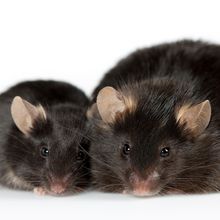Login
Subscribemouse model

Mice Fed a Highly Processed Diet Are More Susceptible to the Flu
Alejandra Manjarrez, PhD | Nov 18, 2022 | 3 min read
It’s not clear why grain-fed mice are better able to recover after infection, but a study’s findings suggest food type may skew the results of animal studies.

Inflammation in Brain’s Immune Cells Triggers Depressive Behavior in Mice
Dan Robitzski | Nov 17, 2022 | 5 min read
In stressful conditions, specialized protein complexes in microglia induce neurotoxic activity in astrocytes that leads to the change in behavior.

The Scientist Speaks Podcast - Episode 11
The Scientist’s Creative Services Team | 1 min read
A Path Back to Health: Immune Tolerance to Infectious Disease

Oral Cancer Survives Starvation with Help from Nearby Nerves
Dan Robitzski | Nov 16, 2022 | 3 min read
Human and mouse oral tumors recruit nerves to produce peptides that the cancer cells need to survive—but this process can be blocked with a migraine drug.

Obesity Protects Against Genital Herpes in Mice, Study Finds
Katherine Irving | Nov 11, 2022 | 3 min read
A high-fat diet induced changes to the animals’ vaginal microbiomes that boosted survival after exposure to the virus.

How Fat Cells Help Kick Parasites Out of Mice: Study
Natalia Mesa, PhD | Oct 14, 2022 | 3 min read
Immune cells get a lot of shine when it comes to fighting infection, but it turns out that fat might be just as important for removing parasitic invaders.

Research Pinpoints the Neurons Behind Feeling Sick
James M. Gaines | Sep 23, 2022 | 5 min read
Specific neurons in the brainstem control sickness behaviors not directly caused by a pathogen, such as tiredness and lack of appetite, a mouse study finds.

Jumping Genes Can Cause Movement Disorder: Study
Sophie Fessl, PhD | Sep 13, 2022 | 3 min read
Mice with overactive LINE-1 retrotransposons in their brains exhibit movement difficulties, suggesting the genetic elements may play a role in ataxia in humans.

Mutation Linked to Difference Between Human and Neanderthal Brains
Dan Robitzski | Sep 9, 2022 | 5 min read
A single amino acid substitution in a protein causes increased neuron production in the frontal lobes of humans compared to Neanderthals—a tiny difference that could have given our species a cognitive edge, researchers say.

Researchers Fuse Mouse Chromosomes in Scientific First
Natalia Mesa, PhD | Aug 25, 2022 | 4 min read
The findings will likely help elucidate the effects of chromosome fusions, which can cause disease but have also contributed to evolution.

Internal Clock Disruptions Increase Colon Cancer Risk in Mice
Shafaq Zia | Aug 19, 2022 | 3 min read
Disturbing circadian rhythms in organoids and mice increases intestinal tumor growth, findings that may explain a recent rise in colon cancer among young adults, the researchers behind the work say.

Phages Treat Gut Inflammation in Mice
Andy Carstens | Aug 4, 2022 | 5 min read
Mixtures of viruses that attack inflammatory bowel disease–causing bacteria in mice also survive the digestive tract and are well-tolerated in humans, a study finds.

Mouse Embryo: No Sperm, Egg, or Uterus Required
Christie Wilcox, PhD | Aug 2, 2022 | 3 min read
Using stem cells and a bioreactor, researchers generated living embryos that survived for more than a week and began to develop internal organs.

Malarial Host-Parasite Clash Causes Deadly Blood Sugar Drop
Natalia Mesa, PhD | Jul 18, 2022 | 4 min read
Scientists say they have finally figured out why some people with severe malaria end up with dangerous hypoglycemia, also reporting that the condition starves the parasite into changing tactics from virulence to transmission.

Mitochondrial Protein Fuels Spread of Head and Neck Cancer
Patience Asanga | Jul 8, 2022 | 3 min read
Head and neck cancer cells lacking the peptide involved in energy production were less likely to metastasize in mice.

While the Body Rests, Breast Cancer Spreads More Aggressively
Alejandra Manjarrez, PhD | Jun 23, 2022 | 4 min read
More cancer cells are shed from primary tumors when individuals are asleep than when they’re awake, according to observations in mouse models and a small cohort of breast cancer patients.

Antioxidants Put the Pep Back in One’s Step
Niki Spahich, PhD | Jun 13, 2022 | 3 min read
Delivering antioxidants via extracellular vesicles to atrophied muscles restores them during rehabilitation.

Diabetes Marker Linked to COVID-19 Severity in Mice
Alejandra Manjarrez, PhD | May 16, 2022 | 3 min read
A sugar that’s less abundant in the blood of people with diabetes binds to SARS-CoV-2’s spike protein and disrupts the virus’s ability to fuse with cells.

Protein Pilfered from Cancer Cells Thwarts Immune Attack
Dan Robitzski | Apr 13, 2022 | 3 min read
New research in mice reveals why natural killer cells, normally effective at hunting cancer, are sometimes stopped in their tracks.
